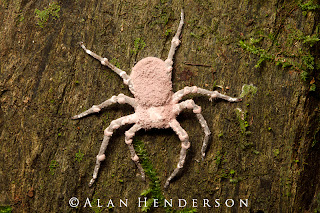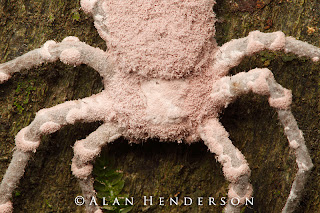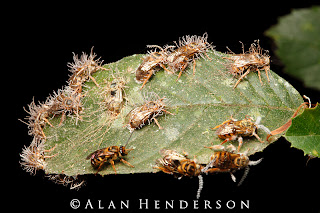I spotted a spider recently at night; it lit up bright white in the torchlight and at first I was completely bewildered at which species I was looking at. It was in a normal hunting posture facing downwards on a tree but something was a little amiss. On closer inspection I found the entire spider engulfed in fungus. This is the third dead huntsman I have found here in the wet tropics in such a state - over taken by something their incredible leg speed can't outrun.
The fungus seems to attack them in such a way that they end up frozen in a normal posture.
A few years ago I observed a similar fungus in action infesting a small congregation of native bees that resided upon the leaves of a rainforest tree. The bees obviously returned to these same leaves regularly, but at some point the fungus would overtake them and they would remain and ultimately die. There were bees in various states of infection; some were dead and completely covered, and others had a partial covering or traces of the fungus. Some appeared healthy and free to come and go, oblivious to the slowly spreading threat nearby.
 |
| What appears to be a Brown Huntsman (Heteropoda jugulans) beneath its death shroud. |
 |
| A close-up of the same fungus-covered spider. |
 |
| The bees. A 'healthy' bee sitting in the foreground with infected and dead bees surrounding it. Some nearby leaves had more healthy bees with less fungal activity. |



Dear Alan, great pictures,
ReplyDeleteThe fungus is maybe an Akanthomyces or Hirsutella, both anamorphs of Cordyceps fungi. Check my pages on Cordyceps:
http://www.danielwinkler.com/cordyceps_sensu_lato.htm
and on tropical Cordyceps:
http://blog.mushroaming.com/2011/03/06/caterpillar-fungus-from-ecuador.aspx
The fungus in this picture is Nomurea atypicola. You can take that to the bank my friend.
ReplyDeleteReferring to the Huntsman
Delete